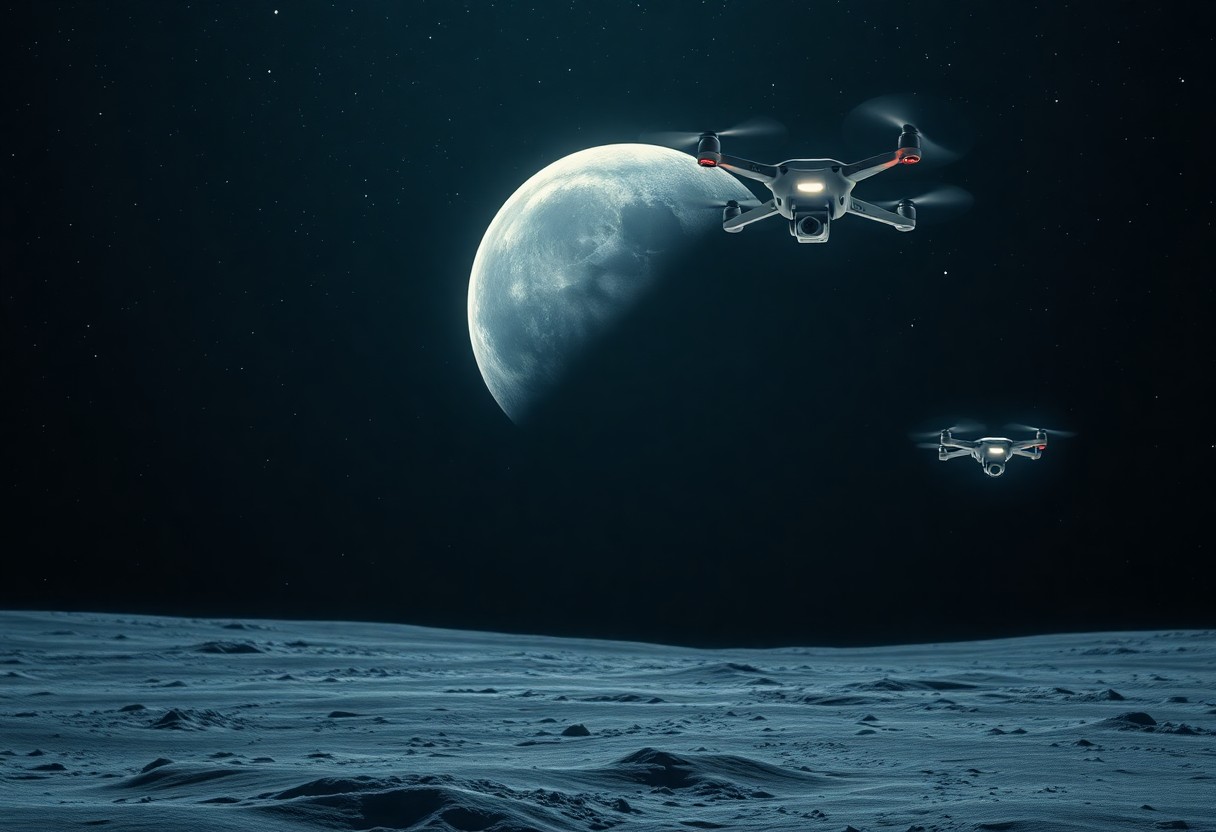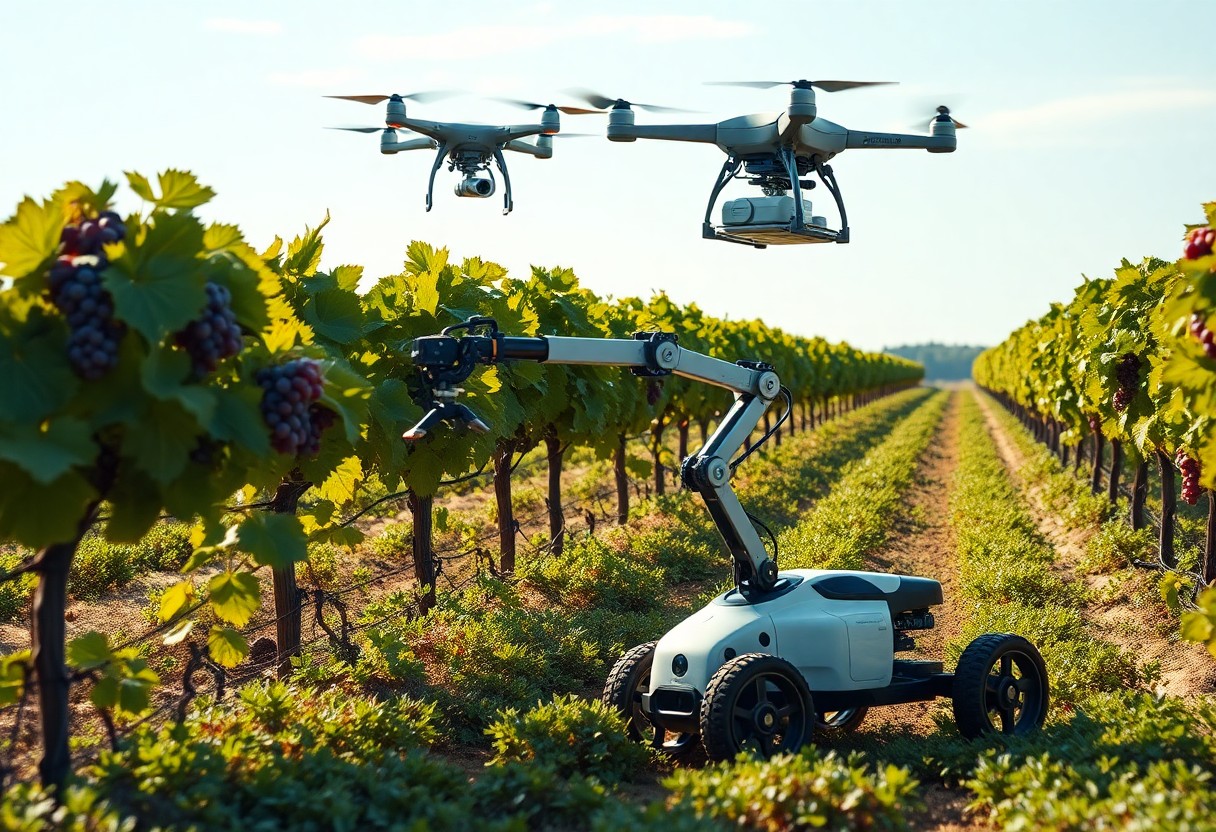Most space enthusiasts are captivated by the enigmatic dark side of the Moon, a realm shrouded in shadows and secrets. As you probe into the potential of luminous drones, you may wonder whether these innovative technologies can unlock the mysteries hidden in this uncharted territory. In this post, we will explore how luminosity and advanced drone capabilities could enhance lunar exploration, shedding light on regions previously untouched by human eyes. Join us as we uncover the possibilities that await your curiosity in lunar research.
The Lunar Dark Side
To understand the lunar dark side, you must first recognize that it refers to the far side of the Moon, which remains largely unseen from Earth due to synchronous rotation. This region is shrouded in mystery, housing vast plains, rugged highlands, and deep craters, creating a world that contrasts sharply with the familiar landscape of the near side. Your perspective on space exploration could change dramatically by uncovering the secrets hidden in this enigmatic realm.
Understanding the Geographical Features
The Moon’s far side showcases an array of geographical features, such as the massive South Pole-Aitken basin, one of the largest and oldest impact craters in the solar system. You will find fewer maria—smooth, dark basaltic plains—compared to the near side, resulting in a rugged surface dominated by craters and highlands. Exploring these formations will give you a deeper insight into lunar geology and its evolutionary history.
Historical Exploration of the Dark Side
Geographical exploration of the lunar dark side has a rich history, marked by significant milestones and groundbreaking missions. In 1959, the Soviet Luna 3 spacecraft became the first to capture images of this unseen territory, revealing the stark contrasts that existed between the near and far sides of the Moon. Your journey through time reveals how technology has evolved, paving the way for more advanced missions that continue to shed light on this mysterious region.
Even as space agencies worldwide have launched numerous missions to explore the Moon, the far side has often been neglected in favor of the more familiar near side. However, as technology advances, missions like China’s Chang’e series have begun to unlock vital information about the far side’s unique geological composition and history. By staying informed on upcoming lunar explorations, you will appreciate the growing body of knowledge being forged about this elusive area and its role in understanding the Moon’s past.

Luminous Drones: Technology Overview
You will find that luminous drones represent a groundbreaking fusion of aerial technology and advanced illumination methods. These drones are designed not only to navigate the varied lunar landscape but also to provide light where it is most needed, unveiling the mysteries hidden in the shadows of the moon’s dark side. With their capabilities, they hold the potential to revolutionize our exploration efforts.
Types of Drones Suitable for Lunar Missions
Suitable drones play a pivotal role in the effective exploration of lunar terrain. Here’s a breakdown of some key types:
| Drone Type | Features |
| Fixed-Wing Drones | Efficient for long-range flights. |
| Multirotor Drones | Versatile with high maneuverability. |
| Solar-Powered Drones | Designed for prolonged missions using solar energy. |
| Rover Drones | Can traverse the lunar surface effectively. |
| Hybrid Drones | Combines features of both fixed-wing and rotor designs. |
This selection of drones ensures versatility, reliability, and the ability to operate effectively in harsh lunar conditions.
Innovations in Illumination Technology
At the forefront of lunar exploration, advancements in illumination technology are transforming how drones operate in low-light conditions. These innovations include LED systems that use less power while producing more light, as well as adaptive lighting techniques that adjust based on terrain and atmospheric conditions.
This capability ensures that drones can illuminate the lunar landscape more effectively, aiding in surface mapping and geological studies while also enhancing navigation. The implementation of such lighting technology promises to extend the operational capabilities of drones, ensuring detailed exploration of even the darkest regions of the lunar surface. Your understanding of these advanced systems will help shape future missions to uncover the moon’s secrets.
Potential Applications of Luminous Drones
The exploration of the lunar dark side presents unique challenges, and luminous drones can offer innovative solutions across various applications. Harnessing their ability to illuminate and capture detailed images can greatly enhance our understanding of this enigmatic portion of the Moon. From mapping to scientific inquiry, these drones can open new pathways for exploration and discovery.
Mapping and Surveying
Any endeavor aimed at mapping the lunar dark side can benefit from the capabilities of luminous drones. By providing real-time illumination, these drones enable precise identification of geological features and surface composition, helping you gather imperative data for comprehensive lunar maps. Their autonomous capabilities and adaptability to harsh conditions will enhance the accuracy of your surveying efforts.
Scientific Research and Data Collection
After deploying luminous drones on the lunar dark side, you can conduct extensive scientific research and gather valuable data. These drones can analyze soil samples, assess temperature fluctuations, and even probe for potential water ice in shadowed craters. Their ability to capture high-resolution images while providing illumination allows you to explore areas otherwise hidden from view, significantly enhancing your understanding of lunar geology and potential resources.
A key advantage of using luminous drones in scientific research is their capability to operate autonomously over extended periods. You can program them to conduct systematic surveys, collect samples, and relay information back to Earth in real-time. This continuous data collection can lead to groundbreaking discoveries, enabling you to piece together the Moon’s history and its potential for supporting future human missions. The insights gained from these drones could reshape our approach to lunar exploration and associated scientific endeavors.
Challenges in Deploying Drones on the Moon
Once again, deploying drones on the Moon presents unique challenges that require innovative solutions. The harsh lunar environment, characterized by extreme temperatures and radiation, poses significant risks to the functionality and longevity of these aerial vehicles. Additionally, the lack of infrastructure for charging or maintenance can complicate long-term missions, requiring thoughtful design and planning to ensure successful operations on the lunar surface.
Environmental Conditions
At the Moon’s surface, environmental conditions fluctuate between severe cold (down to -273°C at night) and intense heat (up to 127°C during the day). Dust and regolith also pose challenges, affecting drone sensors and propulsion systems. The absence of an atmosphere means that any drone design must ensure reliable operations in a vacuum, requiring advanced engineering to withstand these extremes.
Communication and Control Issues
Before initiateing on a mission, you must consider the communication and control issues that arise from the Moon’s distance from Earth. The lag time for signals traveling back and forth can be as long as 2.5 seconds, complicating real-time control and immediate decision-making.
To overcome these communication hurdles, you would need to implement autonomous control systems that enable the drones to operate independently, making decisions based on pre-programmed parameters and real-time environmental assessments. Additionally, establishing relay communication systems, potentially with satellites orbiting the Moon, could enhance data transmission and control capabilities, providing you with a more seamless operational experience.
Case Studies: Previous Drone Missions
Not all drone missions have been focused on the lunar dark side, but several have contributed valuable insights into the feasibility of such explorations. Below is a list illustrating successful drone missions that serve as a foundation for potential lunar applications:
- NASA’s Mars Helicopter Ingenuity – 2021: Conducted 30 flights on Mars, achieving an altitude of 12,000 feet.
- Chinese Chang’e 4 – 2019: First mission to successfully land on the far side of the Moon, sending back over 200 gigabytes of data.
- ESA’s Lunar Orbiter – 2022: Mapped 3D lunar terrain with a resolution of 1 meter, aiding future missions.
- Drone Demonstration for Titan – 2019: Developed high-altitude flight capability for future Titan explorations.
Success Stories
Above all, these successful drone missions exemplify the technological advancements vital for exploring extraterrestrial environments. Each mission has contributed invaluable data and demonstrated varying capabilities that can be adapted to the unique challenges of the lunar dark side.
Lessons Learned
Stories from these missions reveal important insights into operational challenges, environmental influences, and technological limitations. For instance, the Chang’e 4 mission highlighted the potential for communication delays, while Ingenuity showed how autonomous navigation can enhance flight efficiency.
Learned from these experiences, you can appreciate the intricate planning and adaptability required for your future lunar drone operations. Each mission offers lessons on managing obstacles such as unpredictable terrain, maintaining battery life in remote locations, and ensuring reliable communication with Earth. By analyzing these case studies, you can better prepare your drone missions for successful exploration of the lunar dark side.
Future Prospects for Lunar Exploration
Despite advancements in technology, the lunar dark side remains largely unexplored. Future missions will rely on innovative tools and approaches to unveil its secrets, offering new opportunities for discovery. The integration of luminous drones into your lunar exploration initiatives promises to enhance your understanding of this enigmatic region, pushing the boundaries of science and technology as you venture deeper into the mysteries of the Moon.
Role of Luminous Drones in Upcoming Missions
Below, you’ll discover how luminous drones are set to play a pivotal role in your upcoming lunar missions. These advanced drones, equipped with cutting-edge lighting technology, will aid in illuminating dark areas and capturing detailed data, ultimately expanding your knowledge of the Moon’s surface and geological features.
Collaborations and International Efforts
To maximize your exploration capabilities, collaboration with international space agencies will be important. By working together, you can share resources, knowledge, and technological advancements to drive a more comprehensive understanding of the lunar dark side.
Further partnerships with various organizations and countries are expected to enhance your lunar exploration journey. These collaborations can lead to shared missions, joint research programs, and the pooling of financial and scientific resources. By creating a unified approach to lunar exploration, you can benefit from diverse perspectives and innovative ideas, ultimately enriching your understanding of the Moon while fostering a spirit of global cooperation in space research.
Conclusion
Hence, embracing luminous drones to explore the mysteries of the lunar dark side could revolutionize your understanding of our celestial neighbor. These advanced technologies can illuminate previously unseen landscapes and gather vital data, shaping your knowledge of the Moon’s surface and geology. As you witness the evolving potential of these drones, you’ll realize their role in enhancing human exploration and unlocking the secrets hidden in the shadows of the lunar terrain.







